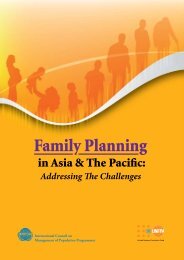Inter-lInkages between PoPulatIon DynamIcs anD DeveloPment In ...
Inter-lInkages between PoPulatIon DynamIcs anD DeveloPment In ...
Inter-lInkages between PoPulatIon DynamIcs anD DeveloPment In ...
You also want an ePaper? Increase the reach of your titles
YUMPU automatically turns print PDFs into web optimized ePapers that Google loves.
EXECUTIVE SUMMARYThe three case studies presented in this publication were prepared for the purpose of understanding howplanning of various development sectors take into account the population and development (POPDEV) interlinkagesand identifying some promising practices to improve consideration of these inter-linkages in thethree countries as well as to promote opportunity for possible South-South collaboration. Based on a preliminaryreview and consultation with the United Nations Population Fund (UNFPA) offices, the countries selected fordocumenting promising practices are Malaysia, <strong>In</strong>dia and Bangladesh - each at different levels of maturity intheir planning processes and sensitivity to POPDEV inter-linkages - which could offer an interesting learningopportunity for other countries. These case studies were prepared through review of policies and plans,relevant secondary literature as well as interviews with key persons in the three countries.Bangladesh’s Experience in POPDEV <strong><strong>In</strong>ter</strong>-linkages in Its Policy and Planning FrameworkBangladesh recognises that the country’s development cannot sustain its rapid population growth. Compoundedwith frequent natural calamities, this has adverse impact on the population’s well-being. Generally, thepolicies acknowledge the adverse impact of population growth on development and plan to address thisthrough improved reproductive health (RH) knowledge and availability of contraceptive and family planning(FP) services. The focus of the policies remains still on reducing fertility through FP while recognising theimportance of gender equality to accelerate the progress in achieving the Millennium Development Goals(MDGs). The policy framework, nevertheless, is somewhat weak as development policies have yet to fullytake into consideration their effect on population dynamics.A review of the Second Poverty Reduction Strategic Paper (PRSP 2), 2009-2011 indicates that the keysectors do consider the consequences of population dynamics. Despite that, population variables are treatedas independent variables regardless of changes in development variables, and population projections arebased on past trends. This affects the accuracy and relevance of the data used for development planning.The lack of gender disaggregated data also influences the degree sectors consider gender dimensions in theirplanning and implementation. The inter-linkages of POPDEV is rather weak in some sectors - HIV/AIDS,education, employment, gender and environment. To effectively address POPDEV inter-linkages, it is essentialto integrate POPDEV considerations into national planning; coordinated sectoral response at district level;cross-sectoral collaboration at sub-district/Upazila level; and integrate response at Union level.The PRSP 2 has two promising practices: (i) Health, Nutrition and Population Sector Programme (HNPSP),and (ii) Micro-finance. Major challenges that remain are: population momentum, gender inequality, HIV/AIDS, and natural disaster. With the new ruling government, much is expected from them to improve thestate of the country.<strong>In</strong>dia’s Experience in POPDEV <strong><strong>In</strong>ter</strong>-linkages in Its Policy and Planning FrameworkHistorically, the focus of the policies in <strong>In</strong>dia has been on reducing fertility and promoting the use of FP.Currently, policies on population, health, youth and HIV/AIDS generally recognise the adverse impact ofpopulation growth on development and seek to address this through increased contraceptive use. Whileacknowledging that socio-economic development, particularly enhanced gender equity, will have an impacton fertility, they do not urge shifts in general development policy. A strong policy framework exists forresponding to mitigate the impact of rapid population growth on development. However, the framework isweak on tweaking development policies themselves for indirectly influencing the fertility rate.v














